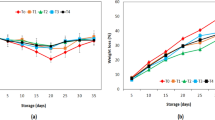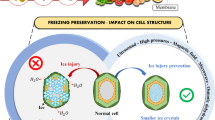Abstract
The quality and preservation of fresh-cut fruits can be improved by applying mild, non-thermal pre-treatments, such as osmotic dehydration (OD). The aim was to model the effect of OD on mass transfer and quality preservation. Apricot pieces were immersed in multi-component solutions comprising glycerol, erythritol, steviol glucosides and mineral salts, at various time–temperature conditions (25–45 °C for 3–240 min, wfruit/wsolution = 1/5). Water loss (WL), solid gain (SG), water activity (aw) as well as main quality indices (colour, texture) were measured during OD. OD apricot exhibited higher quality retention (acceptable level of colour change, increased firmness) suggesting that OD can be an effective pre-processing step in the production of innovative products. A second degree polynomial model was developed, describing the effect of processing conditions and glycerol concentration on WL, SG, aw, colour and texture of osmotically dehydrated apricots, and ANOVA was applied to identify the factors that significantly affect the aforementioned parameters.





Similar content being viewed by others
Abbreviations
- α0 :
-
Constant of the second degree polynomial model
- αi :
-
Coefficients representing the linear effects of the factors of the second degree polynomial model
- αii :
-
Coefficients representing the interaction effects of the factors of the second degree polynomial model
- a :
-
Red (positive)–green (negative)
- a 0 :
-
a at initial osmotic treatment time zero (0)
- b :
-
Yellow (positive)–blue (positive)
- b 0 :
-
b at initial osmotic treatment time
- aw :
-
Water activity
- C glycerol :
-
Glycerol concentration (% w/w)
- D es :
-
Effective coefficient of solid diffusivity (m2/s)
- D es,ο1,2 :
-
Effective coefficient constant of solid diffusivity (m2/s)
- D ew :
-
Effective coefficient of water diffusivity (m2/s)
- D ew,ο1,2 :
-
Effective coefficient constant of water diffusivity (m2/s)
- E a :
-
Activation energy (kJ/mol)
- F max :
-
Maximum peak force (g)
- L :
-
Lightness or whiteness (100 for white to 0 for black)
- L 0 :
-
L at initial osmotic treatment time zero (0)
- M 0 :
-
Initial mass of fresh material (g)
- m 0 :
-
Dry mass of fresh material (g)
- M t :
-
Mass after time t of osmotic treatment (g)
- m t :
-
Dry mass after time t of osmotic treatment (g)
- M ∞ :
-
Mass at equilibrium (g)
- MR :
-
Diffused moisture ratio
- OD:
-
Osmotic dehydration
- R :
-
Universal gas constant (8.314 kJ/mol K)
- RSM:
-
Response surface methodology
- r :
-
Average radius of apricot (m)
- S 0 :
-
Initial solid content of fresh material (g)
- S t :
-
Solid content after time t of osmotic treatment (g)
- S ∞ :
-
Solid content at equilibrium (g)
- SG:
-
Solid gain (g of total solids/g initial dry matter)
- SR :
-
Diffused solid ratio
- T:
-
Osmotic treatment temperature (°C)
- T :
-
Temperature (K) of the Arrhenius equation
- t :
-
Osmotic treatment time (min)
- Xi :
-
Factor variables of the second degree polynomial model
- Y:
-
Response variables of the second degree polynomial model
- WL:
-
Water loss (g of water/g initial dry matter)
- ΔE:
-
Total color change or difference
- ∞ :
-
At equilibrium
- 0:
-
Initial (at time zero)
- t :
-
At time t
References
Ahmed I, Qazi IM, Jamal S (2016) Developments in osmotic dehydration technique for the preservation of fruits and vegetables. Innov Food Sci Emerg 34:29–43
Amami E, Khezami L, Vorobiev E, Kechaou N (2008) Effect of pulsed electric field and osmotic dehydration pre-treatment on the convective drying of carrot tissue. Dry Technol 26:231–238
Assis FR, Morais RMSC, Morais AMMB (2017) Osmotic dehydration with sorbitol combined with hot air convective drying of apple cubes. J Food Sci Technol 54(10):3152–3160
Chiu M-T, Tham HJ, Lee J-S (2017) Optimization of osmotic dehydration of Terung Asam (Solanum lasiocarpum Dunal). J Food Sci Technol 54(10):3327–3337
da Silva WP, de Farias Aires JE, de Castro DS, da Silva e Silva CMDP (2014) Numerical description of guava osmotic dehydration including shrinkage and variable effective mass diffusivity. LWT Food Sci Technol 59(2–1):859–866
Delgado T, Pereira JA, Ramalhosa E, Casal S (2017) Osmotic dehydration effects on major and minor components of chestnut (Castanea sativa Mill.) slices. J Food Sci Technol 54(9):2694–2703
Dermesonluoglu E, Zachariou I, Andreou V, Taoukis PS (2016) Effect of electric fields on mass transfer and quality of osmotically dehydrated kiwifruit. Food Bioprod Process 100(B):535–544
Ella Missang C, Maingonnat J-F, Renard CMGC, Audergon J-M (2011) Texture variation in apricot fruit: intra-fruit heterogeneity, impact of thinning and relation with the texture after cooking. Food Res Int 44:46–53
Eren İ, Kaymak-Ertekin F (2007) Optimization of osmotic dehydration of potato using response surface methodology. J Food Eng 79:344–352
Forni E, Sormani A, Scalise S, Torreggiani D (1997) The influence of sugar composition on the colour stability of osmodehydrofrozen intermediate moisture apricots. Food Res Int 30:87–94
Fratianni A, Niro S, Messia MC, Cinquanta L, Panfili G, Albanese D, Di Matteo M (2016) Kinetics of carotenoids degradation and furosine formation in dried apricots (Prunus armeniaca L.). Food Res Int 99(2):862–867
Heredia A, Peinado I, Rosa E, Andrés A (2010) Effect of osmotic pre-treatment and microwave heating on lycopene degradation and isomerization in cherry tomato. Food Chem 123:92–98
İspir A, Togrul TI (2009) The influence of application of pre-treatment on the osmotic dehydration of apricots. J Food Process Preserv 33:58–74
Jain SK, Verma RC, Murdia LK, Jain GK, Sharma GP (2011) Optimization of process parameters for osmotic dehydration of papaya cubes. J Food Sci Technol 48(2):211–217
Katsoufi S, Lazou AE, Giannakourou MC, Krokida MK (2017) Mass transfer kinetics and quality attributes of osmo-dehydrated candied pumpkins using nutritious sweeteners. J Food Sci Technol 54(10):3338–3348
Lemus-Mondaca R, Vega-Gálvez A, Zura-Bravo L, Ah-Hen K (2012) Stevia rebaudiana Bertoni, source of a high-potency natural sweetener: a comprehensive review on the biochemical, nutritional and functional aspects. Food Chem 132(3):1121–1132
Li H, Wei B, Wub C, Zhang B, Xu X, Jin Z, Tian Y (2014) Modelling and optimisation of enzymatic extrusion pretreatment of broken rice for rice wine manufacture. Food Chem 150:94–98
Liu H, Chen F, Lai S, Tao J, Yang H, Jiao Z (2017) Effects of calcium treatment and low temperature storage on cell wall polysaccharide nanostructures and quality of postharvest apricot (Prunus armeniaca). Food Chem 225:87–97
Mendonça K, Correa J, Junqueira J, Angelis-Pereira M, Cirillo M (2017) Mass transfer kinetics of the osmotic dehydration of yacon slices with polyols. J Food Process Pres 41:e12983
Mercali GD, Marczak LDF, Tessaro IC, Norena CZ (2011) Evaluation of water, sucrose and NaCl effective diffusivities during osmotic dehydration of banana (Musa sapientum, shum). LWT Food Sci Technol 44(1):82–91
Moon HJ, Jeya M, Kim IW, Lee JK (2010) Biotechnological production of erythritol and its applications. J Appl Microbiol Biotechnol 86:1017–1025
Moreno J, Simpson R, Pizarro N, Parada K, Pinilla N, Reyes JE, Almonacid S (2012) Effect of ohmic heating and vacuum impregnation on the quality and microbial stability of osmotically dehydrated strawberries (cv. Camarosa). J Food Eng 110:310–316
Mune Mune MA, Minka SR (2017) Production and characterization of cowpea protein hydrolysate with optimum nitrogen solubility by enzymatic hydrolysis using pepsin. J Sci Food Agric 97(8):2561–2568
Penicaud C, Achir N, Dhuique-Mayer C, Dornier M, Bohuon P (2011) Degradation of β-carotene during fruit and vegetable processing or storage: reaction mechanisms and kinetic aspects: a review. Fruits 66:417–440
Raj D, Sharma PC, Sharera SK (2015) Studies on osmo-air dehydration of different Indian apricot (Prunus armeniaca L.) cultivars. J Food Sci Technol 52(6):3794–3802
Riva M, Campolongo S, Leva AA, Maestrelli A, Torreggiani D (2005) Structure-property relationships in osmo-air-dehydrated apricot cubes. Food Res Int 38:533–542
Rodriguez A, García MA, Campañone LA (2016) Experimental study of the application of edible coatings in pumpkin sticks submitted to osmotic dehydration. Dry Technol 34(6):635–644
Roopa N, Chaukan OP, Raju PS, Das Gupta DK, Singh RKR, Bawa AS (2014) Process optimization for osmo-dehydrated carambola (Averrhoa carambola L.) slices and its storage studies. J Food Sci Technol 51(10):2472–2480
Salazar-López EI, Jiménez M, Salazar R, Azuara E (2015) Incorporation of microcapsules in pineapple intercellular tissue using osmotic dehydration and microencapsulation method. Food Bioprocess Technol 8(8):1699–1706
Terkmane N, Krea M, Moulai-Mostefa N (2016) Optimisation of inulin extraction from globe artichoke (Cynara cardunculus L. subsp. scolymus (L.) Hegi) by electromagnetic induction heating process. Int J Food Sci Technol 51(9):1997–2008
Thalerngnawachart S, Duangmal K (2016) Influence of humectants on the drying kinetics, water mobility, and moisture sorption isotherm of osmosed air-dried papaya. Dry Technol 34(5):574–583
Toğrul IT, İspir A (2008) Equilibrium distribution coefficients during osmotic dehydration of apricot. Food Bioprod Process 86(4):254–267
Toivonen P, Brummell DA (2008) Biochemical baes of appearance and texture changes, in fresh-cut fruit and vegetables. Postharvest Biol Technol 48(1):1–14
Tsiraki MI, Savvaidis IN (2016) The effects of citrus extract (Citrox©) on the naturally occurring microflora and inoculated pathogens, Bacillus cereus and Salmonella enterica, in a model food system and the traditional Greek yogurt based salad Tzatziki. Food Microbiol 53:150–155
Yadav AK, Singh SV (2014) Osmotic dehydration of fruits and vegetables: a review. J Food Sci Technol 51(9):1654–1673
Yadav BS, Yadav RB, Jatain M (2012) Optimization of osmotic dehydration conditions of peach slices in sucrose solution using response surface methodology. J Food Sci Technol 49(5):547–555
Author information
Authors and Affiliations
Corresponding author
Electronic supplementary material
Below is the link to the electronic supplementary material.
Rights and permissions
About this article
Cite this article
Dermesonlouoglou, E.K., Giannakourou, M.C. Modelling dehydration of apricot in a non-conventional multi-component osmotic solution: effect on mass transfer kinetics and quality characteristics. J Food Sci Technol 55, 4079–4089 (2018). https://doi.org/10.1007/s13197-018-3334-4
Revised:
Accepted:
Published:
Issue Date:
DOI: https://doi.org/10.1007/s13197-018-3334-4




